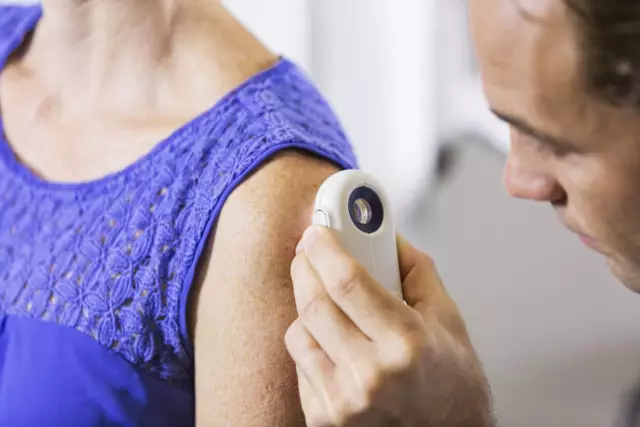- Author Rachel Wainwright [email protected].
- Public 2023-12-15 07:39.
- Last modified 2025-11-02 20:14.
Abscess
The content of the article:
- Abscess Causes and Risk Factors
- Forms of the disease
- Abscess symptoms
- Diagnosis of an abscess
- Abscess treatment
- Potential consequences and complications
- Forecast
- Prevention
An abscess (abscess, abscess) is a purulent inflammation, accompanied by tissue melting and the formation of a cavity filled with pus. It can form in muscles, subcutaneous tissue, bones, internal organs, or in the surrounding tissue.

Abscess formation
Abscess Causes and Risk Factors
The cause of the abscess is pyogenic microflora, which enters the patient's body through damage to the mucous membranes or skin, or is brought in with the blood flow from another primary focus of inflammation (hematogenous pathway).
The causative agent in most cases is a mixed microbial flora, in which staphylococci and streptococci predominate in combination with various types of bacilli, for example, E. coli. In recent years, the role of anaerobes (clostridia and bacteroids), as well as the association of anaerobic and aerobic microorganisms in the development of abscesses, has significantly increased.
Sometimes there are situations when the pus obtained during the opening of the abscess when sown on traditional nutrient media does not give microflora growth. This indicates that in these cases the disease is caused by uncharacteristic pathogens, which cannot be detected by conventional diagnostic methods. To a certain extent, this explains the cases of abscesses with an atypical course.

The main cause of an abscess is the penetration of pyogenic microflora through the skin and mucous membranes.
Abscesses can occur as an independent disease, but more often they are a complication of any other pathology. For example, pneumonia can be complicated by a lung abscess, and purulent tonsillitis can be complicated by a paratonsillar abscess.
With the development of purulent inflammation, the body's defense system tends to localize it, which leads to the formation of a limiting capsule.
Forms of the disease
Depending on the location:
- subphrenic abscess;
- retropharyngeal;
- paratonsillar;
- periopharyngeal;
- soft tissues;
- lung;
- brain;
- prostate gland;
- periodontal;
- intestines;
- pancreas;
- scrotum;
- Douglas space;
- appendicular;
- liver and subhepatic; and etc.
According to the peculiarities of the clinical course, the following forms of abscess are distinguished:
- Hot or spicy. It is accompanied by a pronounced local inflammatory reaction, as well as a violation of the general condition.
- Cold. It differs from a normal abscess in the absence of general and local signs of the inflammatory process (fever, skin redness, pain). This form of the disease is typical for certain stages of actinomycosis and osteoarticular tuberculosis.
- Indented. The formation of a site of accumulation of pus does not lead to the development of an acute inflammatory reaction. The formation of an abscess occurs over a long time (up to several months). Develops against the background of osteoarticular tuberculosis.
Abscess symptoms
The clinical picture of the disease is determined by many factors and, first of all, by the place of localization of the purulent process, the cause of the abscess, its size, and the stage of formation.
Symptoms of an abscess localized in superficial soft tissues are:
- swelling;
- redness;
- sharp soreness;
- an increase in local, and in some cases, general temperature;
- dysfunction;
- fluctuation.
Abdominal abscesses are manifested by the following symptoms:
- intermittent (intermittent) fever with a hectic type of temperature curve, i.e. subject to significant fluctuations during the day;
- severe chills;
- tachycardia;
- headache, muscle and joint pain;
- lack of appetite;
- severe weakness;
- nausea and vomiting;
- delay in passing gas and stool;
- tension of the muscles of the abdominal wall.
When the abscess is localized in the subphrenic region, patients may be disturbed by shortness of breath, cough, pain in the upper abdomen, which intensifies at the moment of inhalation and radiates to the scapula and shoulder.
With pelvic abscesses, reflex irritation of the rectum and bladder occurs, which is accompanied by the appearance of tenesmus (false urge to defecate), diarrhea, and frequent urination.
Retroperitoneal abscesses are accompanied by pain in the lower back, the intensity of which increases with the flexion of the legs in the hip joints.
Symptoms of a brain abscess are similar to those of any other masses (cysts, tumors, hematomas) and can vary in a very wide range, ranging from minor headache to severe cerebral symptoms.
A lung abscess is characterized by a significant increase in body temperature, accompanied by severe chills. Patients complain of pain in the chest area, aggravated by trying to take a deep breath, shortness of breath and dry cough. After opening the abscess in the bronchus, a strong cough occurs with profuse sputum discharge, after which the patient's condition begins to improve rapidly.
Abscesses in the oropharynx (retropharyngeal, paratonsillar, periopharyngeal) in most cases develop as a complication of purulent tonsillitis. They are characterized by the following symptoms:
- severe pain radiating to the teeth or ear;
- sensation of a foreign body in the throat;
- muscle spasm that prevents opening of the mouth;
- soreness and swelling of regional lymph nodes;
- increased body temperature;
- insomnia;
- weakness;
- nasal voice;
- the appearance of an unpleasant putrid odor from the mouth.
Diagnosis of an abscess
Superficial soft tissue abscesses do not cause difficulties in diagnosis. With a deeper location, it may be necessary to perform ultrasound and / or diagnostic puncture. The material obtained during the puncture is sent for bacteriological examination, which makes it possible to identify the causative agent of the disease and determine its sensitivity to antibiotics.
Oropharyngeal abscesses are detected during an otolaryngological examination.
It is much more difficult to diagnose abscesses of the brain, abdominal cavity, lungs. In this case, an instrumental examination is carried out, which may include:
- Ultrasound of the abdominal and pelvic organs;
- magnetic resonance imaging or computed tomography;
- radiography.

With a deep location of the abscess, ultrasound and diagnostic puncture are performed
In a general blood test for any localization of an abscess, signs characteristic of an acute inflammatory process (an increase in the number of leukocytes, a shift in the leukocyte formula to the left, an increase in ESR) are determined.
Abscess treatment
At the initial stage of the development of an abscess of superficial soft tissues, anti-inflammatory therapy is prescribed. After the abscess has matured, it is opened, usually on an outpatient basis. Hospitalization is indicated only in case of a serious general condition of the patient, anaerobic nature of the infectious process.
It is recommended to use Ilon ointment as an aid in treatment, as well as for the prevention of complications of abscesses of subcutaneous fat. The ointment should be applied to the affected area under a sterile gauze bandage or patch. Depending on the degree of suppuration, the dressing should be changed once or twice a day. The duration of treatment depends on the severity of the inflammatory process, but, on average, to obtain a satisfactory result, you need to apply the ointment for at least five days. Ilon K ointment is sold in pharmacies.

Ilon K ointment
Treatment of a lung abscess begins with broad-spectrum antibiotics. After receiving the antibioticogram, the antibiotic therapy is corrected taking into account the sensitivity of the pathogen. In the presence of indications, bronchoalveolar lavage is performed in order to improve the outflow of purulent contents. The ineffectiveness of conservative treatment of an abscess is an indication for surgical intervention - resection (removal) of the affected area of the lung.

Abdominal abscesses are surgically removed
Treatment of brain abscesses in most cases is surgical, as they can lead to dislocation of the brain and cause death. A contraindication to the removal of abscesses is their localization in deep and vital structures (subcortical nuclei, brain stem, optic tubercle). In this case, they resort to puncture of the abscess cavity, removal of purulent contents by aspiration, followed by rinsing the cavity with an antiseptic solution. If multiple flushing is required, the catheter through which it is administered is left in the cavity for a while.
Abdominal abscesses are surgically removed.
Potential consequences and complications
Untimely treatment abscesses can lead to serious complications:
- neuritis;
- osteomyelitis;
- phlegmon;
- purulent fusion of the blood vessel wall with the occurrence of life-threatening bleeding;
- purulent meningitis;
- empyema of the pleura;
- peritonitis;
- sepsis.
Forecast
The prognosis depends on the location of the abscess, the timeliness and adequacy of the treatment. Subcutaneous tissue abscesses usually result in complete recovery. With abscesses of the brain, the prognosis is always very serious, death is observed in 10% of cases, and 50% of patients develop persistent disability.
Prevention
Prevention of the development of abscesses is aimed at preventing the ingress of pathogenic pyogenic microflora into the patient's body and includes the following measures:
- careful observance of asepsis and antiseptics during medical interventions accompanied by damage to the skin;
- timely conduct of primary surgical treatment of wounds;
- active sanitation of foci of chronic infection;
- increasing the body's defenses.
YouTube video related to the article:

Elena Minkina Doctor anesthesiologist-resuscitator About the author
Education: graduated from the Tashkent State Medical Institute, specializing in general medicine in 1991. Repeatedly passed refresher courses.
Work experience: anesthesiologist-resuscitator of the city maternity complex, resuscitator of the hemodialysis department.
The information is generalized and provided for informational purposes only. At the first sign of illness, see your doctor. Self-medication is hazardous to health!






